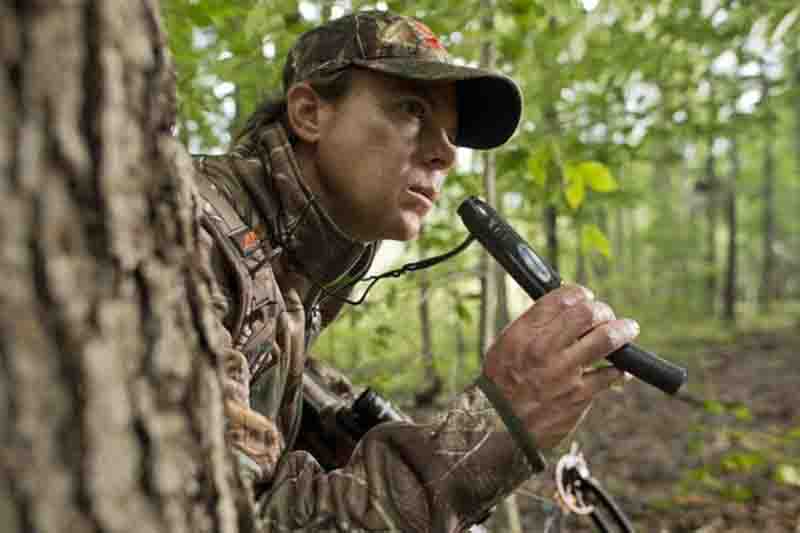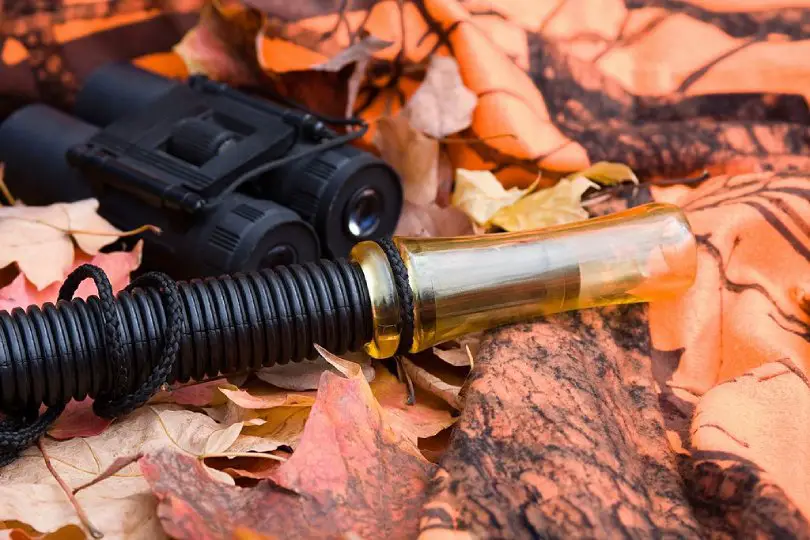Regarding waterfowl hunting, calling is one of the most effective tactics. Most hunters will not attempt hunting without giving a call.
But how to use a deep call properly? What types are there, and which works how? — I’m sure you have been baffled by these questions at least once, especially if you’re a beginner. That’s why we’re here to help.
This guide is wrapped around providing a solid idea about how to use a deer call, the different types available, how they work, and how to use them properly. If you’re searching the internet for deer calling for dummies or beginners, you’re in luck!
Who knows, you might start looking for deer calls as soon as you finish reading this blog!
How to Use a Deer Call: Everything You Need to Know

1. Bleats
Buck grunts are isolated sounds. Although, when they are being chased, they tend to grunt continuously. Bleat call is similar to the sounds created by fawn or doe.
Fawns are known to bleat whenever they chase or look out for their mother. In times like this, they make sounds in the woods.
Using bleat can be a perfect choice if your focus is on does. They tend to use the bleat sound whenever they look out for a lost fawn. Though bleats are great when it comes to calling, most estrous does get bleat once a buck chases after them.
The sound can signal most doe during heat into most competitive bucks within an area. So, how to call in a doe effortlessly? Use these bleat sounds, and you’ll see some action soon enough.
You need to ensure the entire flipped is over before creating a bleat. You can give 2 – 4 bleats at once within a period of 20 – 30 minutes.
2. Grunts
This is the best way to call in a buck and the most common practice globally. If you have observed bucks grunt whenever they fight, they tend to create rubs and scrapes; chasing does at any specific time.
Occasionally, you can see a buck grunting while it walks across the woods. Grunt calls are effective whenever a buck comes to sight, and this is most times out of range.
The sound appears as a challenge, so they often try to check out what makes such a sound. One of the major mistakes most hunters make is to try the grunt call when the gaze of a buck is completely focused on them.
Doing this will only get you spotted regardless of how high you are on a tree. Using grunt tubes is one of the most effective strategies beginners find more appealing.
It is advisable to blow 1 -2 note calls within 20 to 30 minutes. I have found this strategy to be beneficial when carrying out a pre-rut.
3. Rattling
Rattling is another common call strategy you can use to mimic a buck fight. Real antlers can be used, antlers produced by factories, or rattle bags.
Although lots of people think slugfest is the best when rattling. Most times, all you need might be a couple of crashes.
Most young bucks are known to spar without getting involved with it. Fighting March, most times, attracts the biggest bucks that are out there to boss over little guys.
If a heavyweight match is recreated, you have succeeded in decreasing the chance of attracting a deer, and this is because –younger bucks don’t participate in a big fight.
I used to make a couple of quick rattles once I observed a buck moving off from a stand site. It is also vital not to rattle once you discover the buck gazing at you.
Once the mood gets to them, most times, they run straight to the raffle. You can use rattling at all times, but I prefer rattling in the early season and going straight up.
Once you have the rut get to the peck, the order is created, causing the bucks to mate.
Rattle anytime you spot a deer getting away from your space, or do this once every hour; this will help attract more of their attention from a distance.
You can also have a blend of grunts to add more reality to the sound.
4. Wheezing
This is also referred to as a snort wheeze; this calling method is effective when it comes to calling mature bucks. When it comes to dominance calls, this is the ultimate.
Whenever mature bucks want to intimidate a younger subordinate – wheezing is used. If you intend to call on younger bucks, you should stay clear from using this calling method.
If you gasped this at most young bucks, running for safety becomes their next option for survival. On the other hand, most dominant bucks will yield to the challenge by getting close.
One of the perfect things about wheezes is that –you don’t need to buy or use a call.
The wheezing sound can create the sound with quick breathing alongside your teeth clenched while your mouth is barely open. Once all the facial positioning is rightly done, try exhaling quickly while your mouth is still held in the same position.
This works perfectly; if you observe the bucks moving away from you.
Although the strategy doesn’t work often, and most times, if it is done before a deer is spotted out, then it is possible to spook off younger bucks.
Your step to deer calling is not something mystical. Similar to any other types of hunting measures, which most time does not yield a grantee outcome. Although if the style is used correctly, deer calls will be an additional hunting tool within your arsenal.
5. Blind Calling
When should you try calling with this call strategy? Let’s take; for instance, you spotted a deer you intend to lure within your shooting range.
And you read the body language and make the necessary adjustments on the right call. For instance, you sight the buck bristles, seeking a fight.
Once you have tried that out with rattling, sometimes it can fall for your final grunts, which can most times pinpoint your ideal position.
In contrast, when a buck is wary and tries to turn off from the sound, you can use a social grunt since they might want to flee anytime they hear something aggressive.
Although many calling setups are done when no deer is in sight, this process is known as blind calling.
And it works most time flawlessly, especially during the pre to early rut phases carried out close to bedding areas.
Most of these areas are thick, making it easy for most deer to hear vocalizations and activities without having direct access to the source of the sound.
6. Doe Bleat and Grunt
Deer are generally vocal, although many hunters have not acknowledged this fact.
This is because they produce a silent sound that is quite challenging to detect, except they come very close to your stand.
A grunt and doe bleat is one of the most effective when it comes to pre-and post-rut. It is essential to know that most secondary rut takes place within a month immediately after the first rut peck.
The main reason most doe sounds effective is pretty simple –most bucks are out there looking for a doe they can breed.
Stick closely to the standard rules when calling a deer, whenever you intend to use the grunt or bleats calls. Mouth-blow or tip-over calls can also be used carefully.
Produce a few bleats every 20- 35 minutes while you stay back and watch how the bucks try to sneak to the position to sniff the doe.
Anytime a call is made, make sure the deer is positioned downwind, and if this smells instead of the hot doe, the buck will have to get out of sight.
Whenever you intend to use the blown doe call, practicing to perfection in a truck or in the comfort of your house is essential. While heading to your hunting spot, you can still rehearse the “Baaawwl.”
Do this carefully, and try as much as possible not to get spotted out by a buck. If this is used in the early hours of the morning, it is vital to be a bit patient and wait to have a good shooting spot and view before you proceed with the first bleat.
Conclusion
Deer calling can be a compelling tactic if done right. It allows you to successfully lure a doe or a buck within the range of your bow or rifle.
If carried out properly, the process is satisfying and exciting to behold. How you effectively communicate with the wild animal until it responds can be amazing, don’t you think?
Although sometimes calling fails, blending different types of calls into a tactical repertoire will make you a better-rounded bow hunter.
And with this, we conclude our today’s guide on how to use a deer caller effectively. Throughout this guide, we’ve provided an overview of different types of deer calls and how to use deer calls properly. Hope you find all this information helpful.
FAQs
Q. 1: Do deer calls work?
A. When it comes to pre-rut, carrying out a deer call with trail grunts works perfectly, as most bucks get to rut mode in search of receptive does. Lastly, most tending grunts are known as grunt variation, which a buck can use once it acquires a doe.
Q. 2: How often should I use a doe bleat?
A. A mouth-blown or tip-over doe bleater can be used carefully. You can go by making a few bleats within 20 – 35 minutes of intervals, afterward, observe downwind until a bucks sneak in an attempt to sniff the doe. You can use a doe estrous urine set on each stand to your location, making your hunt scent-free.
Q. 3: How often should you grunt for deer?
A. Stick to the standard rules when performing a deer call, irrespective of the technique used, whether grunt calls or bleats. Mouth-blown or tip-over calls should be used frugally. Try as much as possible to make a few bleats within 20 -35 minutes of interval while watching downwind carefully to spot when a buck sneaks in to sniff the doe.
Q. 4: How to call bucks in during the rut?
A. This is one of the reasons why fawn bleat is considered one of the most effective ways to deer call when it comes to does attraction. Let’s say you intend to go after a fully grown, mature buck. Using fawn bleats will help increase a buck’s curiosity and, as a result, directs it within your range.
Q. 5: How often should you use a deer call?
A. It is best to use a series of short calls followed by periods of silence. This allows the deer to become accustomed to your call and gives them time to investigate the source of the noise. In areas with dense populations, it may be necessary to call more frequently to locate deer movement.








Leave a Comment